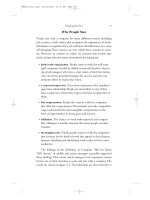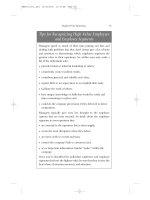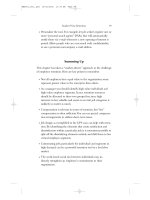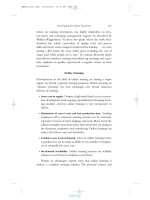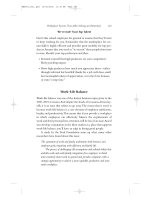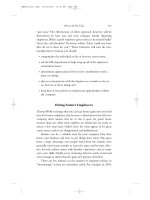Hiring and Keeping the Best People 13
Bạn đang xem bản rút gọn của tài liệu. Xem và tải ngay bản đầy đủ của tài liệu tại đây (141.88 KB, 8 trang )
people in that job to do every day.You may be able to cure the
turnover problem through job redesign: adding variety to a
repetitive job, engaging isolated employees in occasional team
projects, upping the challenge, and so forth. If a job involves
one or more repugnant tasks, consider eliminating or out-
sourcing those tasks.
8.
Identify potential defectors early.
Great work environments and
great jobs are a matter of opinion; what challenges one person
may terrify another.You won’t know how well you’re doing on
either score unless you ask.
As a manager, you routinely interact and share views with
your direct reports.Think about adding “defection detection”
to these communications. Doing so will help you identify
potential defectors in time to take effective countermeasures.
Conduct a “stay interview” by asking people how they feel
about their assignments, company policies, and the working
environment.Ask about individual goals, whether they feel
included or excluded by the corporate culture, and what would
keep them with the company. For an interactive tool on con-
ducting a stay interview, please visit www.elearning.hbsp.org/busi-
nesstools. Hartford Life starts this process six months after an
employee is hired, with a formal session asking what employees
think about the company. (See “Tips for Detecting Potential
Defectors” for more information about this process.)
While you’re at it, get feedback on your performance as a
manager.Arrow Electronics uses a “360-degree feedback”
system, monitored by the CEO to determine whether its man-
agers are actually providing the feedback and coaching that
they should.
9.
Be a retention-oriented manager.
Never forget that part of your
responsibility as a manager is to assure proper staffing in your
unit. Retaining good and excellent performers is part that job.
So look at how you manage people and how you schedule
work flow.Are you the kind of boss who manages in ways that
encourage the best people to stay, or are you unknowingly
driving them away?
Keeping the Best 83
HBE001_ch3_.qxd 10/02/2002 11:34 AM Page 83
84 Hiring and Keeping the Best People
Are some of your people considering leaving? B. Lynn Ware,
founder of the retention consulting firm ITS, Inc., counsels
clients to watch for early signs of dissatisfaction and disaffection,
including:
•
a change in behavior, such as coming in later or leaving
earlier;
•
a decline in performance;
•
sudden complaints from a person who hasn’t been a
complainer;
•
wistful references to other companies (for example,“I heard
of this guy who got a $30,000 signing bonus at XYZ
Company”);
•
withdrawal behavior (for example, an employee who had
always participated in meetings or volunteered for projects,
suddenly stays in the background or does just enough to get
by); and
•
talk about “burnout.”
If you see one of these warning signals, get right on it. Arrange
to meet with the employee as soon as possible. Use probing
questions to identify the source of the problem. Indicate that
you value him or her as an employee, and ask how you can work
together to creating a better work experience.
Tips for Detecting Potential Defectors
source:
“Employee Retention:What Managers Can Do,” Harvard Management Update, April 2000.
HBE001_ch3_.qxd 10/02/2002 11:34 AM Page 84
Summing Up
This chapter has described major issues relating to employee reten-
tion and highlighted ways in which managers can make a difference.
In particular:
•
Retention matters because high turnover creates high replace-
ment costs and is clearly associated with low levels of customer
satisfaction, customer loyalty, and lost revenues.
•
Retention is particularly challenging today due to a number of
factors—in particular, an aging work force and a growing
imbalance in the supply and demand of qualified personnel. In
addition, today’s workers have different expectations about
work-life balance.
•
People stay with their employers when they see the organiza-
tion as a source of pride and affiliation, when they respect their
supervisors, when they are fairly compensated, and when they
perceive their work as meaningful.
•
People seek greener pastures when leadership changes unfavor-
ably, when they are in conflict with their immediate superiors,
when close friends depart, and when their responsibilities
change in ways that they do not favor.
•
Managers can make a difference by following the nine “Manag-
ing for Retention” points outlined in this chapter.
Keeping the Best 85
HBE001_ch3_.qxd 10/02/2002 11:34 AM Page 85
This Page Intentionally Left Blank
Market-Wise Retention
Competing in the War for Talent
4
Key Topics Covered in This Chapter
•
Differentiating between employees in terms
of economic value to the organization
•
Seven market-based strategies for improving
retention
HBE001_ch4_.qxd 10/02/2002 11:34 AM Page 87
TEAMFLY
Team-Fly
®
